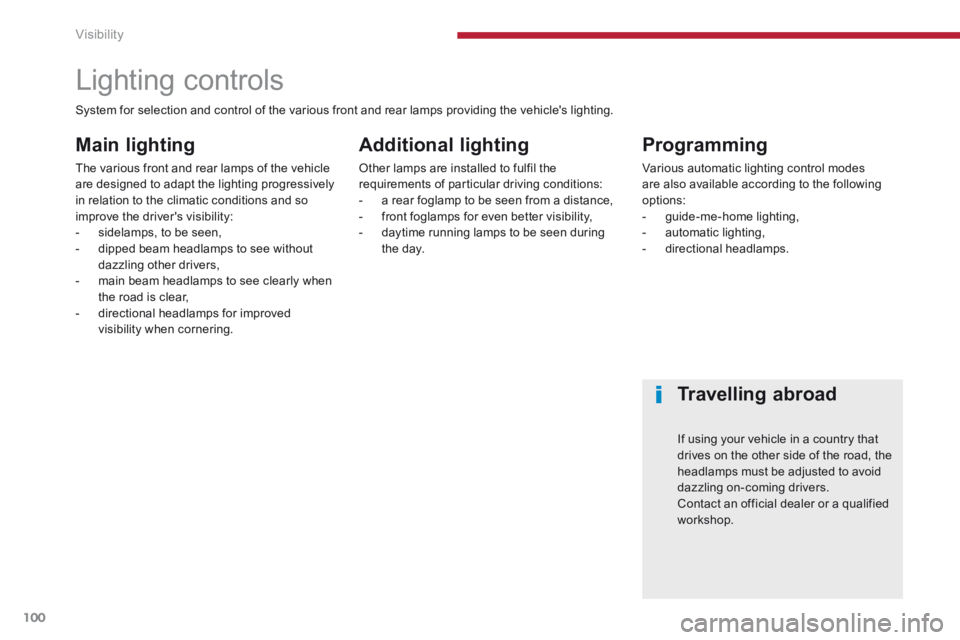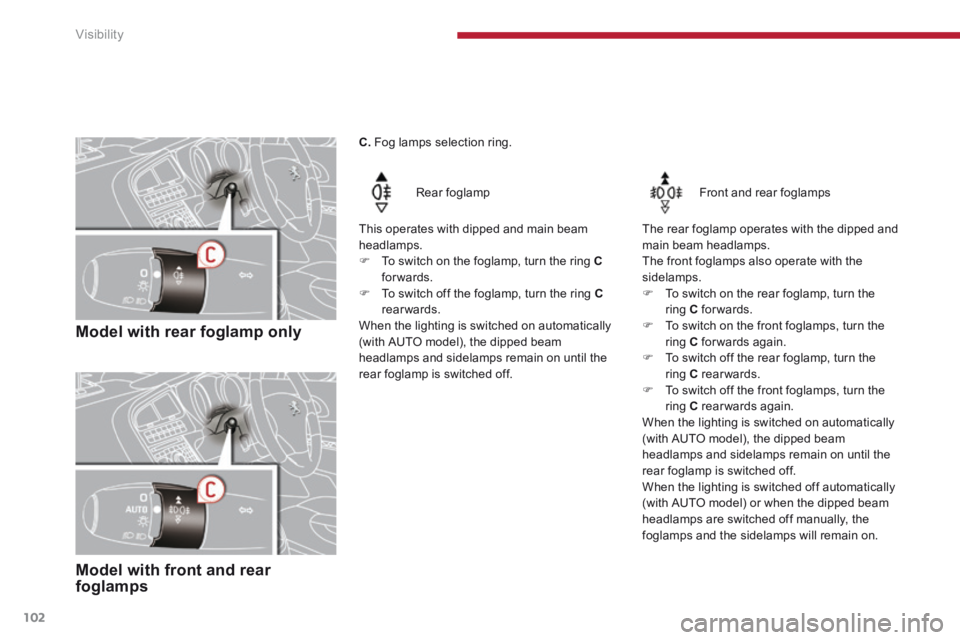2013.5 PEUGEOT 5008 fog light
[x] Cancel search: fog lightPage 16 of 404

101
102152
109
11 0
Familiarisation
14
Seeing clearly
Lighting
Ring A
Lighting off.
Ring B
Sidelamps.
Dipped / main beam headlamps.
Rear foglamp.
or
Front and rear foglamps.
Automatic illumination of headlamps.
Direction indicators
Raise or lower the lighting stalk passing the point of resistance; the corresponding direction indicators will flash for as long as the stalk remains in this position.
"Three fl ashes" function
Press the lighting stalk up or down once, without passing the point of resistance; the corresponding direction indicators will flash three times. This function can be used at any speed, but it is particularly useful when changing lane on
high-speed roads.
Wipers
Stalk A: windscreen wipers
Switching on "AUTO"
Press the stalk down and release it.
Switching off "AUTO"
Push the stalk up and return it to position "0" .
Ring B: rear wiper
Park.
Intermittent wipe.
Wash-wipe.
Page 27 of 404

.Familiarisation25
Eco-driving
Optimise the use of your
gearbox
With a manual gearbox, move off gently and change up without waiting. During acceleration change up early.
With an automatic or electronic gearbox, give preference to automatic mode and avoid pressing the accelerator pedal heavily or suddenly.
The gear shift indicator invites you engage the most suitable gear: as soon as the indication is displayed in the instrument panel, follow it straight away. With an electronic or automatic gearbox, this indicator appears only in manual mode.
Drive smoothly
Maintain a safe distance between vehicles, use engine braking rather than the brake pedal, and press the accelerator progressively. These practices contribute towards a reduction in fuel consumption and CO2 emissions and also helps reduce the background traffic noise.
If your vehicle has cruise control, make use of the system at speeds above 25 mph (40 km/h) when the traffic is flowing well.
Remember to make use of equipment that can help keep the temperature in the passenger compartment down (sunroof and window blinds...). Switch off the air conditioning, unless it has
automatic regulation, as soon as the desired temperature is attained. Switch off the demisting and defrosting controls, if not automatic. Switch off the heated seat as soon as possible.
Switch off the headlamps and front foglamps when the level of light does not require their use.
Avoid running the engine before moving off, particularly in winter; your vehicle will warm up much faster while driving.
Eco-driving is a range of everyday practices that allow the motorist to optimise their fuel consumption and CO2 emissions.
As a passenger, if you avoid connecting your multimedia devices (film, music, video game...), you will contribute towards limiting the consumption of electrical energy, and so of fuel. Disconnect your portable devices before leaving the vehicle.
Control the use of your
electrical equipment
Before moving off, if the passenger compartment is too warm, ventilate it by opening the windows and air vents before using the air conditioning. Above 30 mph (50 km/h), close the windows and leave the air vents open.
Page 33 of 404

1
Monitoring31
Diesel engine pre-heating fixed. The ignition switch is at the 2nd position (ignition on). Wait until the warning lamp has switched off before starting. The duration for which the warning lamp is on is determined by the climatic conditions.
Dipped beam headlamps fixed. The lighting stalk is in the "Dipped beam headlamps" position.
Main beam
headlamps
fixed. The lighting stalk is pulled towards you. Pull the stalk to return to dipped beam headlamps.
Front foglamps fixed. The front foglamps are switched on. Turn the ring on the stalk rear wards twiceto switch off the front foglamps.
Rear foglamps fixed. The rear foglamps are switched on. Turn the ring on the stalk rear wards to switch off the rear foglamps.
Electric parking brake fixed. The electric parking brake is applied. Release the electric parking brake to switch off the warning lamp: with your foot on the brake pedal, pull the electric parking brake control lever. Observe the safety recommendations. For more information on the electric parking brake, refer to the corresponding section.
Warning lampis onCauseAction/Observations
Page 102 of 404

Visibility
100
Lighting controls
Main lighting
The various front and rear lamps of the vehicle are designed to adapt the lighting progressively in relation to the climatic conditions and so improve the driver's visibility: - sidelamps, to be seen, - dipped beam headlamps to see without dazzling other drivers, - main beam headlamps to see clearly when the road is clear, - directional headlamps for improved visibility when cornering.
Additional lighting
Other lamps are installed to fulfil the requirements of particular driving conditions: - a rear foglamp to be seen from a distance, - front foglamps for even better visibility, - daytime running lamps to be seen during the day.
Programming
Various automatic lighting control modes are also available according to the following options: - guide-me-home lighting, - automatic lighting, - directional headlamps.
System for selection and control of the various front and rear lamps providing the vehicle's lighting.
Travelling abroad
If using your vehicle in a country that drives on the other side of the road, the headlamps must be adjusted to avoid dazzling on-coming drivers. Contact an official dealer or a qualified workshop.
Page 104 of 404

Visibility
102
Model with rear foglamp only
Rear foglamp
This operates with dipped and main beam headlamps. To switch on the foglamp, turn the ring Cforwards. To switch off the foglamp, turn the ring Crearwards. When the lighting is switched on automatically (with AUTO model), the dipped beam headlamps and sidelamps remain on until the rear foglamp is switched off.
Model with front and rear foglamps
Front and rear foglamps
The rear foglamp operates with the dipped and main beam headlamps. The front foglamps also operate with the sidelamps. To switch on the rear foglamp, turn the ring C forwards. To switch on the front foglamps, turn the ring C forwards again. To switch off the rear foglamp, turn the ring C rearwards. To switch off the front foglamps, turn the ring C rearwards again. When the lighting is switched on automatically
(with AUTO model), the dipped beam headlamps and sidelamps remain on until the rear foglamp is switched off. When the lighting is switched off automatically (with AUTO model) or when the dipped beam headlamps are switched off manually, the foglamps and the sidelamps will remain on.
C. Fog lamps selection ring.
Page 105 of 404

5
Visibility103
Switching off the lighting when switching off the ignition
When the ignition is switched off, all of the lamps switch off immediately, except for the dipped beam headlamps if automatic guide-me-home lighting is activated.
In good or rainy weather, by both day and night, the front foglamps and the rear foglamps are prohibited. In these situations, the power of their beams may dazzle other drivers. They should
only be used in fog or falling snow. In these weather conditions, you should switch on the foglamps and dipped beam headlamps manually, as the sunshine sensor may detect sufficient light. Do not forget to switch off the front and rear foglamps when they are no longer necessary.
Switching on the lighting when switching on the ignition
To reactivate the lighting control stalk, turn the ring A to position "0" - lighting off, then to the position of your choice.
If the lighting is switched on manually after switching off the ignition, there is an audible signal when a front door is opened to warn the driver that they have forgotten to switch off the vehicle's lighting, with the ignition off. They switch off automatically after a period which depends on the state of charge of the battery (entry to energy economy mode).
Page 108 of 404

Visibility
106
Automatic "guide-me-
home" lighting
Automatic illumination of headlamps
Activation
Turn the ring to the "AUTO" position. The activation of the function is accompanied by the display of a message in the screen.
Deactivation
Turn the ring to another position. Deactivation of the function is accompanied by the display of a message in the screen.
Operating fault
In the event of a malfunction of the sunshine sensor, the lighting comes on, this warning lamp is displayed in the instrument panel and/or a message appears in the screen, accompanied by an audible signal. Contact a PEUGEOT dealer or a qualified workshop.
When the automatic illumination of headlamps function is activated, under low ambient light the dipped beams headlamps come on
automatically when the ignition is switched off.
Programming
Activation or deactivation, as well as the duration of the guide-me-home lighting, is set in the vehicle configuration menu.
In fog or snow, the sunshine sensor may detect sufficient light. In this case, the lighting will not come on automatically. Do not cover the sunshine sensor, coupled with the rain sensor and located in the centre of the windscreen behind the rear view mirror; the associated functions would no longer be controlled.
When a low level of ambient light is detected by a sunshine sensor, the number plate lamps, sidelamps and dipped beam headlamps are switched on automatically, without any action on the part of the driver. They can also come on if rain is detected, at the same time as automatic operation of the windscreen wipers. As soon as the brightness returns to a sufficient level or after the windscreen wipers are switched off, the lamps are switched off automatically.
Page 233 of 404

11
Practical information231
Changing a bulb
Model with halogen headlamps
1. Direction indicators (light-emitting diodes - LEDs).2. Main beam headlamps (HB3).3. Dipped beam headlamps (H7).4. Daytime running lamps/sidelamps (light-emitting diodes - LEDs).5. Foglamps (PS24W).
1. Direction indicators (light-emitting diodes - LEDs).2. Dipped / main beam directional headlamps (D1S).3. Daytime running lamps / sidelamps (light-emitting diodes - LEDs).4. Foglamps (PS24W).
Model with xenon and directional headlamps Front lamps The headlamps are fitted with polycarbonate glass with a protective coating: do not clean them using a dr y or abrasive cloth, nor with a detergent or solvent product, use a sponge and soapy water or a pH neutral product, when using a high pressure washer on persistent marks, do not keep the lance directed towards the lamps or their edges for too long, so as not to damage their protective coating and seals, do not touch the bulb directly with your fingers, use lint-free cloths.
Changing a bulb should only be done after the headlamp has been switched off for a few minutes (risk of serious burns). It is imperative to use only anti-ultraviolet (UV) type bulbs in order not to damage the headlamp.
Always replace a failed bulb with a new bulb with the same type and specification.
Risk of electrocution
Xenon bulbs (D1S) must be replaced by a PEUGEOT dealer or a qualified workshop.